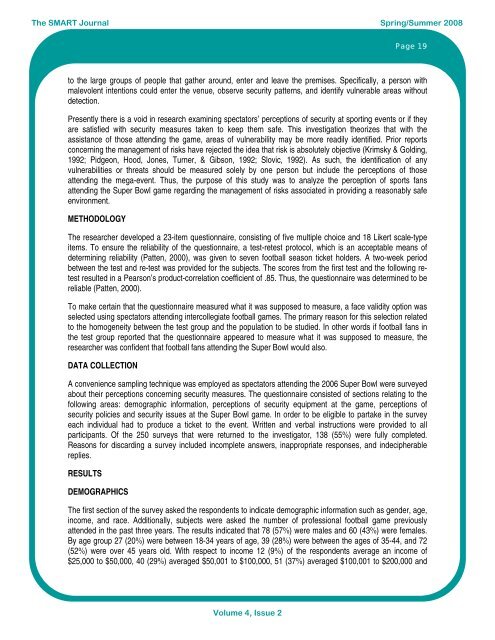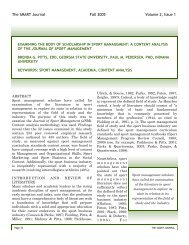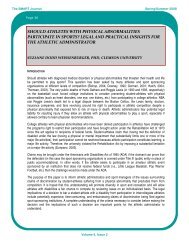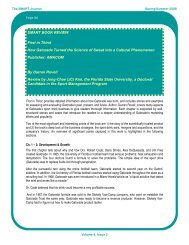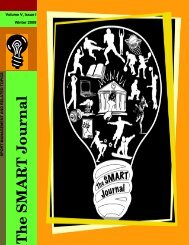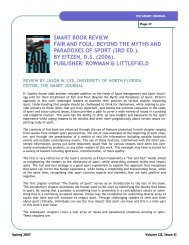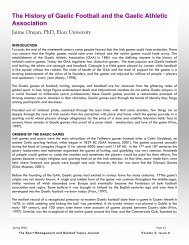Spring/Summer 2008 Volume 4, Issue 2 - The SMART Journal
Spring/Summer 2008 Volume 4, Issue 2 - The SMART Journal
Spring/Summer 2008 Volume 4, Issue 2 - The SMART Journal
Create successful ePaper yourself
Turn your PDF publications into a flip-book with our unique Google optimized e-Paper software.
<strong>The</strong> <strong>SMART</strong> <strong>Journal</strong> <strong>Spring</strong>/<strong>Summer</strong> <strong>2008</strong><br />
Page 19<br />
to the large groups of people that gather around, enter and leave the premises. Specifically, a person with<br />
malevolent intentions could enter the venue, observe security patterns, and identify vulnerable areas without<br />
detection.<br />
Presently there is a void in research examining spectators’ perceptions of security at sporting events or if they<br />
are satisfied with security measures taken to keep them safe. This investigation theorizes that with the<br />
assistance of those attending the game, areas of vulnerability may be more readily identified. Prior reports<br />
concerning the management of risks have rejected the idea that risk is absolutely objective (Krimsky & Golding,<br />
1992; Pidgeon, Hood, Jones, Turner, & Gibson, 1992; Slovic, 1992). As such, the identification of any<br />
vulnerabilities or threats should be measured solely by one person but include the perceptions of those<br />
attending the mega-event. Thus, the purpose of this study was to analyze the perception of sports fans<br />
attending the Super Bowl game regarding the management of risks associated in providing a reasonably safe<br />
environment.<br />
METHODOLOGY<br />
<strong>The</strong> researcher developed a 23-item questionnaire, consisting of five multiple choice and 18 Likert scale-type<br />
items. To ensure the reliability of the questionnaire, a test-retest protocol, which is an acceptable means of<br />
determining reliability (Patten, 2000), was given to seven football season ticket holders. A two-week period<br />
between the test and re-test was provided for the subjects. <strong>The</strong> scores from the first test and the following retest<br />
resulted in a Pearson’s product-correlation coefficient of .85. Thus, the questionnaire was determined to be<br />
reliable (Patten, 2000).<br />
To make certain that the questionnaire measured what it was supposed to measure, a face validity option was<br />
selected using spectators attending intercollegiate football games. <strong>The</strong> primary reason for this selection related<br />
to the homogeneity between the test group and the population to be studied. In other words if football fans in<br />
the test group reported that the questionnaire appeared to measure what it was supposed to measure, the<br />
researcher was confident that football fans attending the Super Bowl would also.<br />
DATA COLLECTION<br />
A convenience sampling technique was employed as spectators attending the 2006 Super Bowl were surveyed<br />
about their perceptions concerning security measures. <strong>The</strong> questionnaire consisted of sections relating to the<br />
following areas: demographic information, perceptions of security equipment at the game, perceptions of<br />
security policies and security issues at the Super Bowl game. In order to be eligible to partake in the survey<br />
each individual had to produce a ticket to the event. Written and verbal instructions were provided to all<br />
participants. Of the 250 surveys that were returned to the investigator, 138 (55%) were fully completed.<br />
Reasons for discarding a survey included incomplete answers, inappropriate responses, and indecipherable<br />
replies.<br />
RESULTS<br />
DEMOGRAPHICS<br />
<strong>The</strong> first section of the survey asked the respondents to indicate demographic information such as gender, age,<br />
income, and race. Additionally, subjects were asked the number of professional football game previously<br />
attended in the past three years. <strong>The</strong> results indicated that 78 (57%) were males and 60 (43%) were females.<br />
By age group 27 (20%) were between 18-34 years of age, 39 (28%) were between the ages of 35-44, and 72<br />
(52%) were over 45 years old. With respect to income 12 (9%) of the respondents average an income of<br />
$25,000 to $50,000, 40 (29%) averaged $50,001 to $100,000, 51 (37%) averaged $100,001 to $200,000 and<br />
<strong>Volume</strong> 4, <strong>Issue</strong> 2


